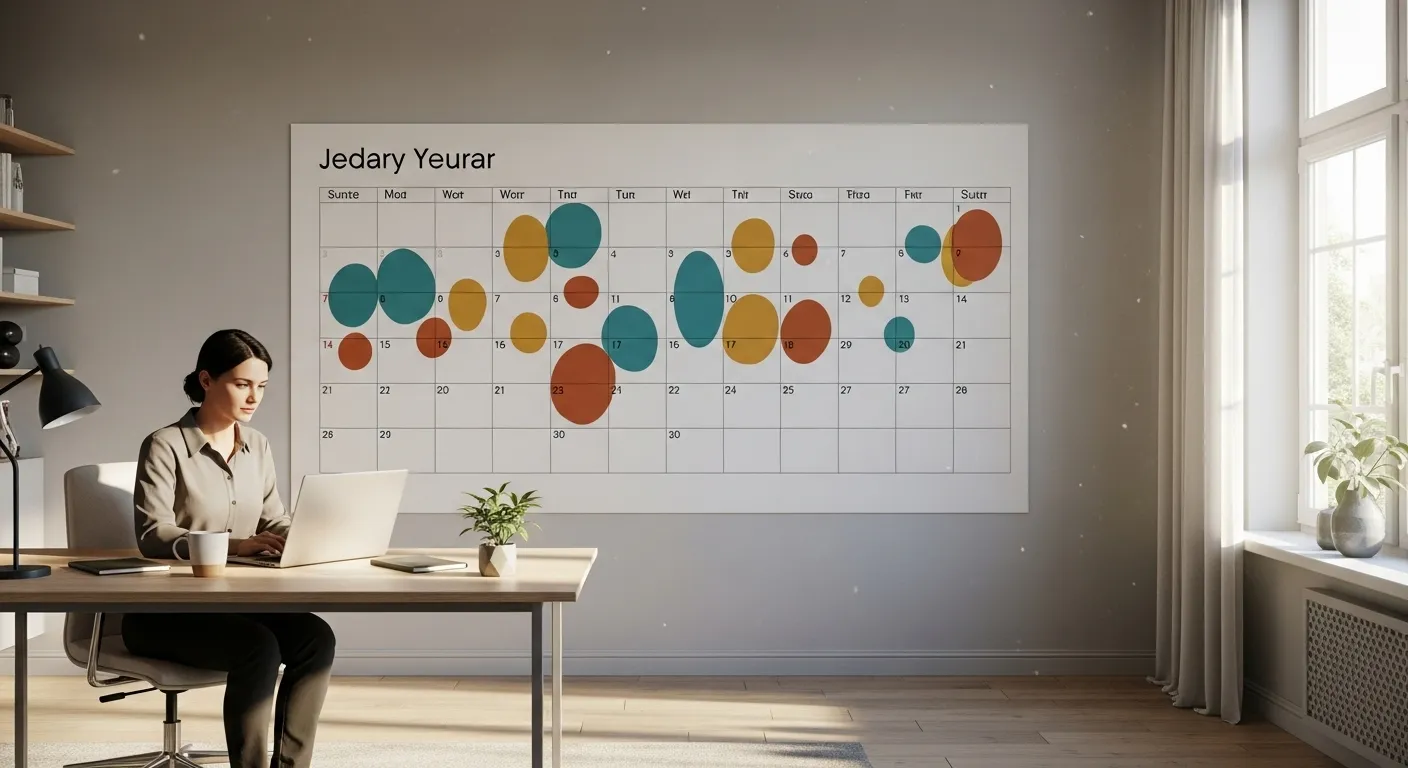
Welcome to TheFocusedMethod.com. We are here to help you find clarity and calm in a world of distraction.
Do you ever feel a sense of mental friction? A feeling like your brain is a browser with too many tabs open. You want to focus. You want to create. But the noise, both internal and external, is overwhelming. One moment you are trying to write a report, and the next you are scrolling through notifications, answering an email, and thinking about your grocery list. At the end of the day, you feel exhausted but not accomplished. You feel busy, but not productive.
If this sounds familiar, you are not alone. This state of constant, low-grade distraction is the new normal for many of us. We have forgotten how to be still. We have come to fear empty moments. We fill every gap in our day with podcasts, social media, and endless streams of information. We have, in effect, engineered boredom out of our lives. And in doing so, we have inadvertently silenced one of our greatest assets for creativity and deep thinking.
This article is a gentle invitation to reclaim that quiet space. We are not going to talk about harsh discipline or impossible productivity hacks. Instead, we are going to explore the surprising power of doing nothing. We will look at why embracing moments of “boredom” is not a sign of laziness, but a strategic tool for a more focused and creative mind. We will uncover the science behind this simple idea and give you practical, gentle rituals to welcome stillness back into your life. You have the capacity for deep, sustained attention. Let us work together to create the conditions for it to flourish.
📚 Table of Contents
- Understanding Your Attention: The Myth of the “Always-On” Brain
- Practical Focus Rituals: Creating Space for Stillness
- 1. The Startup Ritual (5-10 Minutes)
- 2. The Deep Work Entry Ritual (2-5 Minutes)
- 3. Break Hygiene (5-15 Minutes)
- 4. The Shutdown Ritual (5-10 Minutes)
- Your 15-Minute Starter Pack
- Mental Tools for a Focused Mindset
- 1. Reframe Perfectionism as Procrastination
- 2. Intentionally Reduce Friction
- 3. Script Your Reset After Derailment
- Worked Examples: Focus in the Real World
- Frequently Asked Questions About Focus and Boredom
- 1. Is it okay to listen to music or white noise while I work?
- 2. I have been told I am a great multitasker. Is it really that bad?
- 3. What should I do when I feel completely unmotivated and bored?
- 4. My brain feels most active and creative in the evenings. Should I force myself to be a morning person?
- Disclaimer
- Your Seven-Day Focus Challenge: Start Today
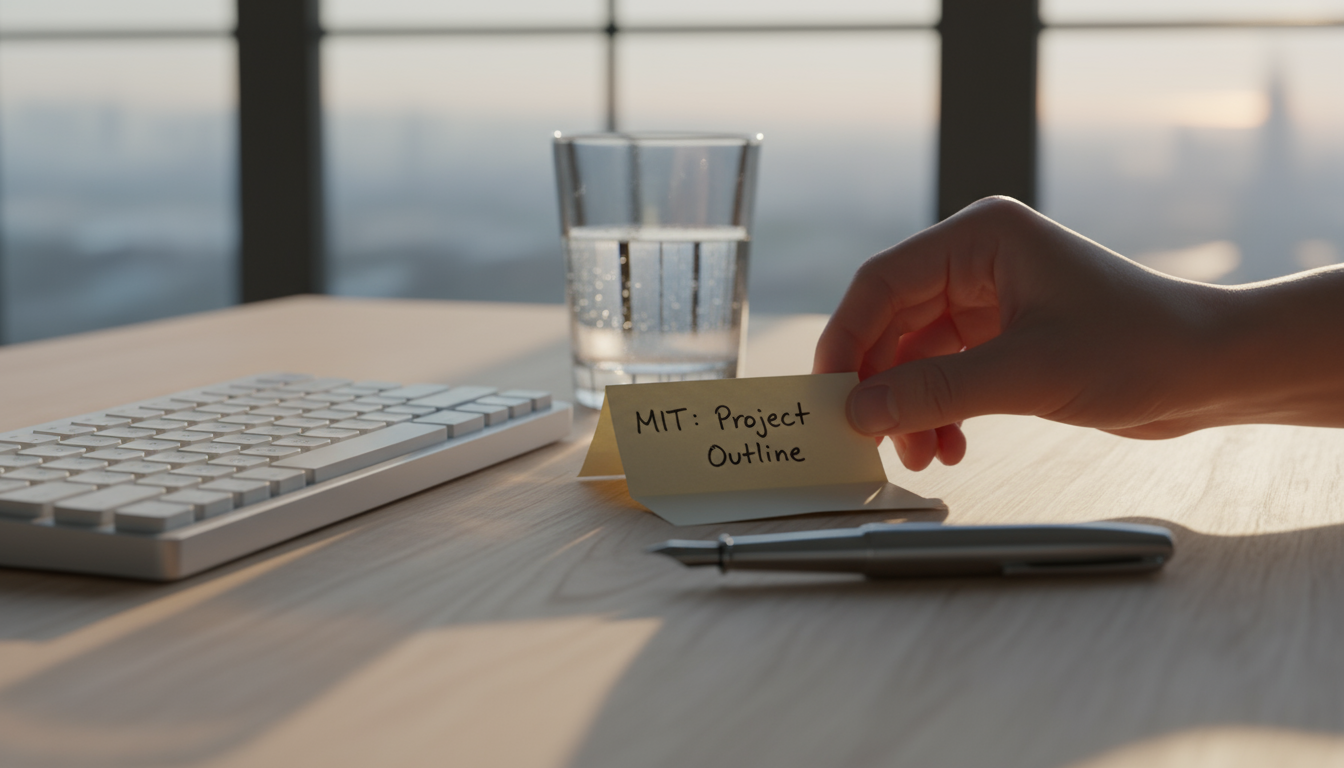
Understanding Your Attention: The Myth of the “Always-On” Brain
Before we can build better focus habits, we need to understand how our attention actually works. Many of us operate under the assumption that our brain should be “on” and productive from the moment we wake up until we go to sleep. This is a deeply unhelpful myth. Your brain is not a machine; it is a biological organ with its own natural rhythms of energy and rest.
Think of your attention as a muscle. You can train it to be stronger, but you can also exhaust it through overuse. When you are constantly switching between tasks, checking your phone, and responding to notifications, you are forcing that muscle into a state of constant tension. This is where we encounter the concept of context switching. Context switching is the act of moving from one unrelated task to another. Every time you do this, your brain pays a price. It takes time and mental energy to disengage from the first task and load up the context for the second one. Studies from organizations like the American Psychological Association (https://www.apa.org) show that even brief mental blocks created by shifting tasks can cost as much as 40 percent of someone’s productive time.
This constant switching dramatically increases your cognitive load. Cognitive load is the total amount of mental effort being used in your working memory. When your cognitive load is too high, you feel overwhelmed, stressed, and unable to think clearly. It is that “too many tabs open” feeling. You cannot process new information effectively, and your ability to solve complex problems plummets. Your brain, desperate for a break, starts seeking out easy, low-effort distractions, creating a vicious cycle of distraction and overwhelm.
So where does boredom fit into this picture? Boredom is the antidote to high cognitive load. It is the brain’s recovery state. When you allow yourself to be bored—to simply stare out a window, take a walk without headphones, or sit quietly with your thoughts—you give your brain a chance to switch off its high-energy “executive network” responsible for focused tasks. In its place, another network comes online: the Default Mode Network (DMN). The DMN is a fascinating part of our neurobiology, extensively studied by institutions like the National Institutes of Health (https://www.nih.gov). It is active when our minds are wandering, daydreaming, or reflecting.
This is where the magic happens. The DMN is the seat of our creativity. It is the part of the brain that connects disparate ideas, retrieves old memories, and simulates future possibilities. When you are stuck on a problem at work, the solution often comes to you in the shower or on a walk precisely because the DMN has been activated. By constantly stimulating ourselves, we prevent this vital network from doing its important work. We are denying ourselves access to our most creative and insightful thoughts.
The benefits of being bored, therefore, are not about being idle. They are about creating the mental space necessary for insight. How boredom boosts creativity is by allowing your mind to move past the immediate, tactical details of a problem and engage in a more expansive, associative mode of thinking. True focus is not about forcing your brain to work nonstop. It is about honoring its natural rhythms of intense effort followed by intentional, unstructured rest. It is about monotasking, not multitasking, and it is about welcoming the quiet moments you have been trained to fear.

Practical Focus Rituals: Creating Space for Stillness
Understanding the theory is one thing. Putting it into practice is another. The goal is not to suddenly find hours of empty time in your day. It is about building small, consistent rituals that create pockets of stillness and intentionality. These rituals help reduce decision fatigue, lower your cognitive load, and make it easier to enter a state of deep work.
Let us define a few terms. A ritual is simply a sequence of actions you perform consistently to signal a transition to your brain. Monotasking, also known as single-tasking, is the practice of focusing on one task at a time without distraction. The ultimate goal of these rituals is to help you achieve a state of flow, a term coined by psychologist Mihaly Csikszentmihalyi. Flow is the experience of being fully immersed in an activity, feeling energized, and performing at your peak. It is the opposite of the scattered, overwhelmed feeling of constant distraction.
Here are four core rituals you can adapt to your own life. Start small. The key is consistency, not intensity.

1. The Startup Ritual (5-10 Minutes)
Your day should not start with a reactive dive into your email inbox. This immediately puts you on the defensive, letting other people’s priorities dictate your mental state. A startup ritual creates a proactive, intentional beginning to your workday.
How to do it: Before you open a single email or message, take five minutes. First, take a few deep breaths to center yourself. Next, look at your plan for the day. If you do not have one, make one now. Identify your single most important task. This is the one thing that, if completed, would make you feel most accomplished. Write it down on a piece of paper and place it next to your keyboard. Finally, take one minute to tidy your physical workspace. A clear space encourages a clear mind. This simple sequence tells your brain, “We are now entering a state of focused work. We are in control.”

2. The Deep Work Entry Ritual (2-5 Minutes)
The hardest part of deep work is often just getting started. We procrastinate because the task feels big and our resistance is high. A deep work entry ritual is a tiny, repeatable habit that helps you cross that threshold of resistance smoothly.
How to do it: This ritual happens right before you begin your most important task. It should be very short and simple. It could be putting on a specific pair of noise-canceling headphones. It could be closing all unnecessary browser tabs and applications on your computer. It could be setting a timer for 25 minutes for a single Pomodoro session. It could be saying a short, encouraging phrase to yourself, like “Let’s begin.” The action itself is less important than its consistency. This ritual acts as a Pavlovian trigger, signaling to your brain that it is time to drop into a state of deep focus.

3. Break Hygiene (5-15 Minutes)
This is where we directly invite boredom back into our lives. Most people take “breaks” by swapping one form of digital stimulation for another. They move from a spreadsheet to social media, or from a report to a news website. This is not a real break; it is just a different kind of cognitive load. It does not allow your brain to rest and recharge.
How to do it: Good break hygiene means disconnecting from screens. For five to fifteen minutes, do something analog and low-stimulation. Stand up, stretch, and walk around. Get a glass of water. Look out a window and just observe what you see without judgment. Tidy a small part of your room. The key is to resist the urge to pick up your phone. At first, this will feel uncomfortable. You will feel the pull of distraction. This is the moment of choice. By choosing to endure that flicker of boredom, you are letting your Default Mode Network activate. You are giving your mind the unstructured time it needs to solve problems in the background. This is one of an essential benefits of being bored.

4. The Shutdown Ritual (5-10 Minutes)
Just as important as how you start your day is how you end it. Without a clear end to the workday, your brain never truly disconnects. Work-related thoughts bleed into your personal time, creating a persistent, low-level anxiety. A shutdown ritual creates a firm boundary.
How to do it: At a set time each day, begin your shutdown. First, review what you accomplished. Acknowledge your progress, no matter how small. Next, quickly plan your top one or two priorities for tomorrow. This “closes the loop” for your brain, preventing those tasks from popping into your head at night. Finally, perform a physical action that signifies the end of work. It could be closing your laptop, turning off your monitor, or saying a specific phrase like “Shutdown complete.” This tells your mind that it is now safe to disengage from work and enter a state of rest.
Your 15-Minute Starter Pack
Feeling overwhelmed? Start here. Commit to this 15-minute routine for one week:
- Morning (5 mins): Before checking your phone, write down your single most important task for the day.
- Mid-day (5 mins): Take one screen-free break. Walk to the kitchen, get some water, and look out the window for five minutes. No phone.
- End of day (5 mins): Write down your main task for tomorrow. Then, close your laptop and say, “Done for today.”
This simple practice begins to build the muscle of intentionality and creates the quiet space your mind craves.

Mental Tools for a Focused Mindset
Building rituals is a powerful external strategy. But to make focus sustainable, we also need to upgrade our internal operating system. Our mindset—the way we think about work, perfection, and setbacks—plays a huge role in our ability to concentrate. Here are three thought tools to help you cultivate a more focus-friendly mindset.
1. Reframe Perfectionism as Procrastination
Perfectionism sounds like a noble trait, but it is often a significant barrier to focus. The desire to do something perfectly can be so intimidating that it prevents us from starting at all. We wait for the “perfect” time, the “perfect” idea, or the “perfect” mood. While we wait, we procrastinate, often by filling our time with easy, distracting activities. This is not the productive, creative boredom we are aiming for; it is anxious avoidance.
The Mindset Shift: Instead of “This has to be perfect,” try “This has to be done.” Give yourself permission to produce a “terrible first draft.” The goal is not to lower your standards forever, but to lower the barrier to entry. Action creates momentum. It is far easier to edit a flawed document than it is to stare at a blank page. Remind yourself that progress, not perfection, is the goal. By starting, you engage with the task and create the opportunity to enter a flow state. Imperfect action is infinitely more productive than perfect inaction.




2. Intentionally Reduce Friction
Our brains are wired to follow the path of least resistance. If checking social media is easy and starting your big project is hard, your brain will choose social media every time. The key is to make your desired behavior easier and your distracting behaviors harder. This is not about willpower; it is about smart environmental design.
The Mindset Shift: Instead of asking, “How can I have more self-control?” ask, “How can I make this easier for my future self?” If you want to focus on writing in the morning, prepare your workspace the night before. Open the document, place a glass of water on your desk, and close all other applications. To make distractions harder, move your social media apps to a folder on the last page of your phone. Use a website blocker during your deep work sessions. Unsubscribe from noisy email newsletters. Each tiny piece of friction you remove from your desired path and add to your distracting path makes it more likely you will follow through. You are not fighting your brain’s nature; you are working with it.
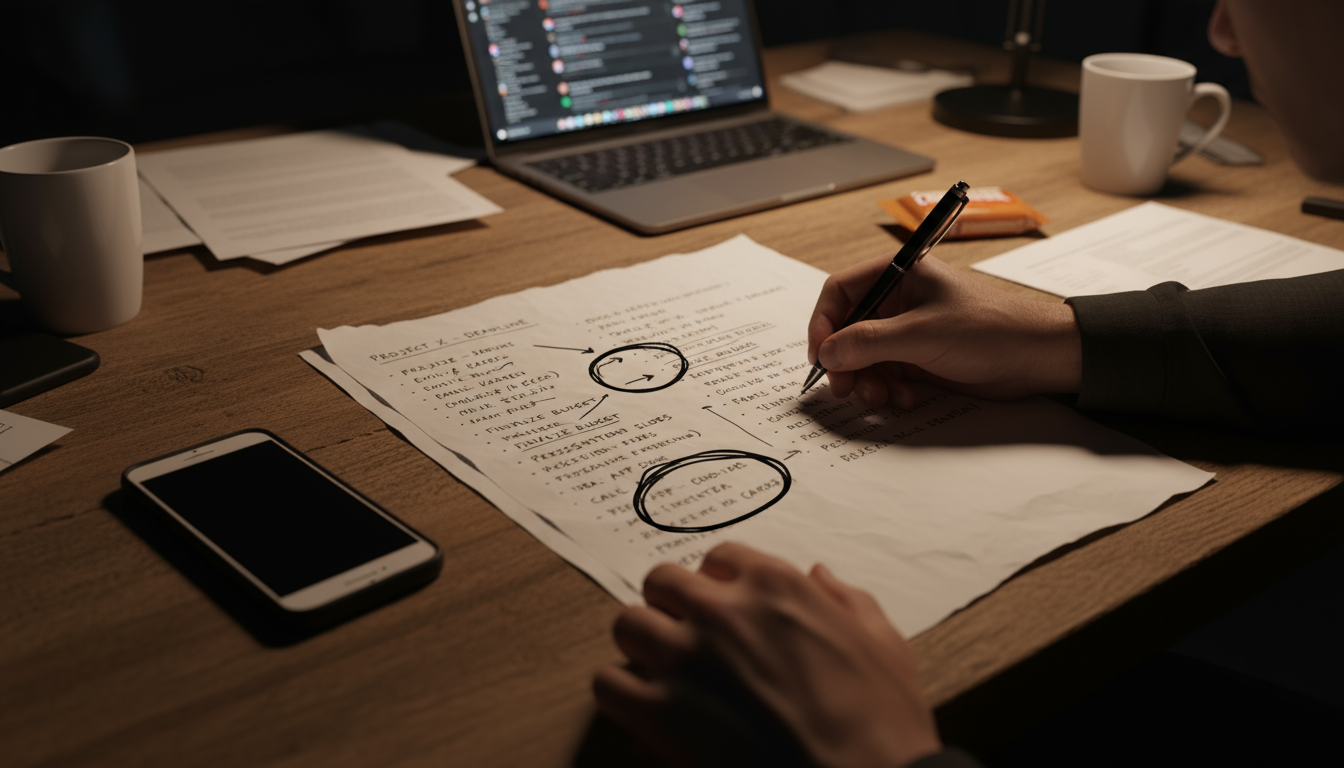
3. Script Your Reset After Derailment
No matter how good your systems are, you will get distracted. You will fall off track. This is not a failure; it is part of being human. The crucial moment is not the distraction itself, but what you do immediately after you realize you have been derailed. Many people fall into a shame spiral. They think, “I’ve ruined my focus for the day, so I might as well give up.” This all-or-nothing thinking is destructive.
The Mindset Shift: Create a simple, non-judgmental reset script for when you get distracted. It should be compassionate and action-oriented. For example, you could say to yourself: “Okay, I got distracted. That happens. Let’s take one deep breath and simply return to the task at hand.” Or, “That was not the plan, but I can still make the next ten minutes focused.” The goal is to close the loop on the distraction without judgment and gently guide your attention back. Each time you do this, you strengthen your “focus muscle” and prove to yourself that a single distraction does not have to derail your entire day. Compassion is a more effective tool for focus than criticism.

Worked Examples: Focus in the Real World
Theory and tools are helpful, but let’s see how these concepts apply in two common, challenging scenarios. The key is not to find a perfect, magic solution, but to apply the principles of ritual, friction reduction, and mindset with gentle consistency.

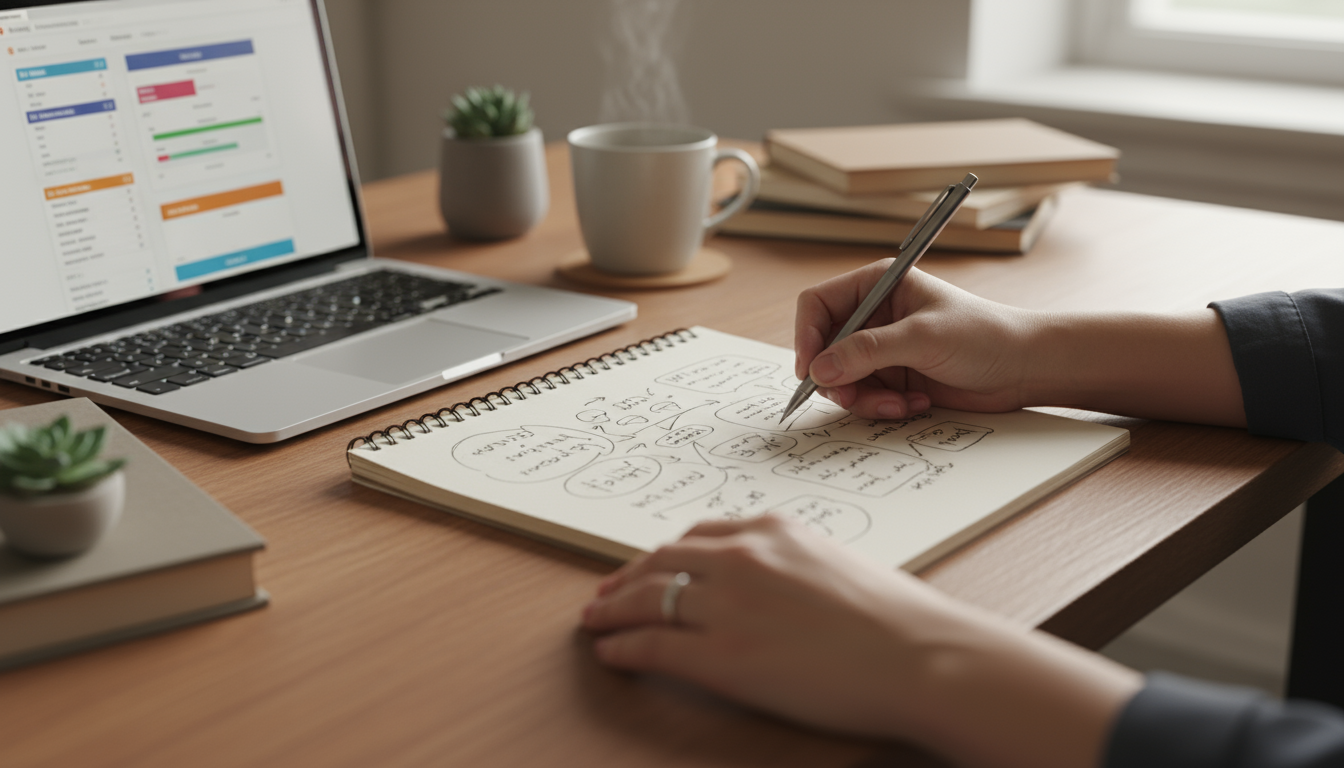
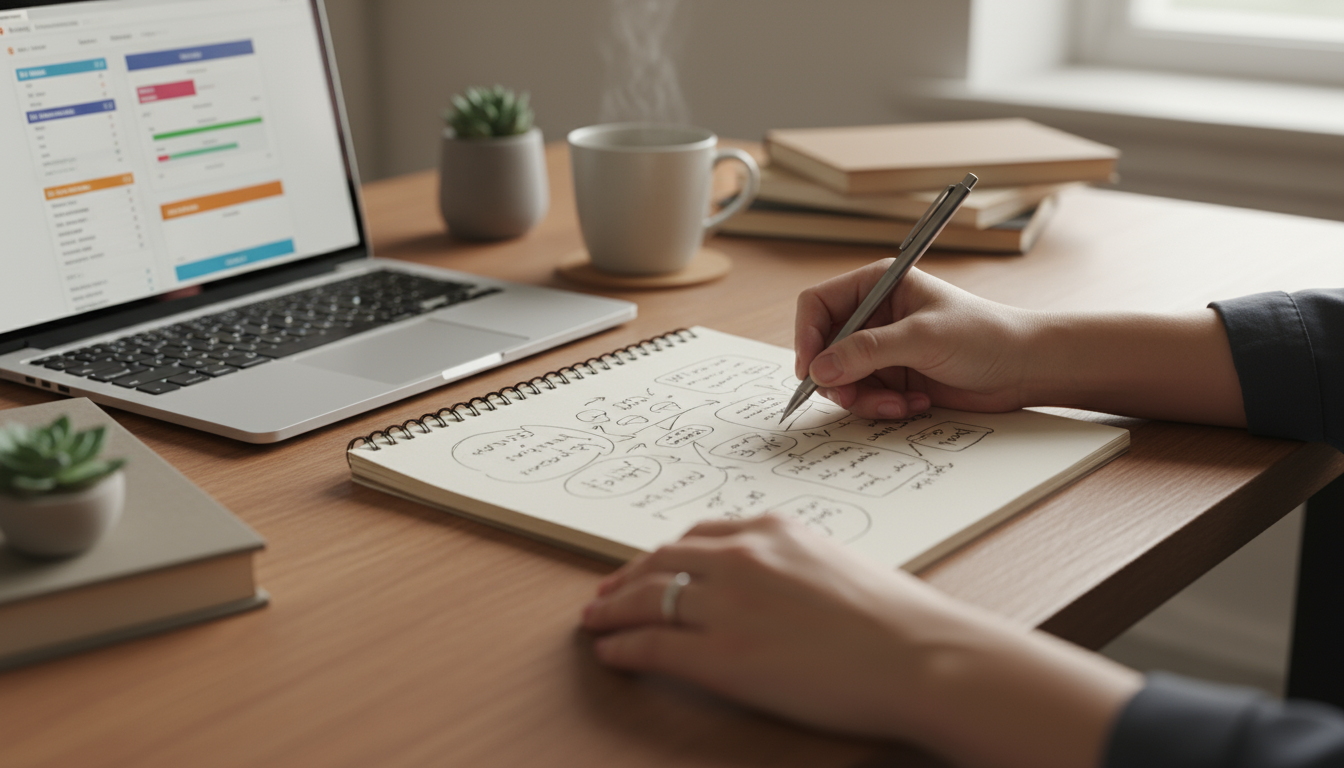

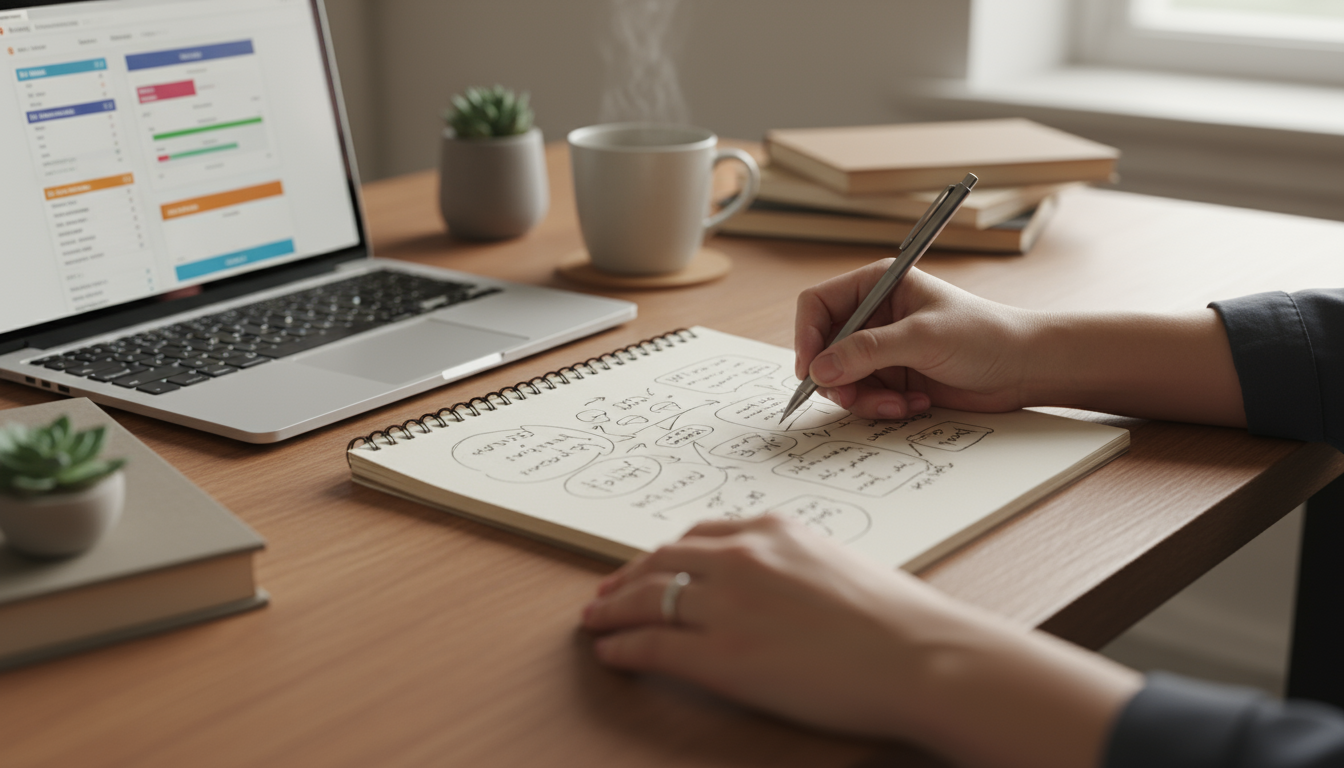


Scenario 1: The Tight Deadline
The Situation: You have a major project due in 48 hours. You feel a rising sense of panic. Your mind is racing, you are tempted to multitask to “get more done,” and every notification feels like a crisis. Your cognitive load is maxed out, and real focus feels impossible.
The Focused Method Approach:
1. Start with a “Brain Dump” Startup Ritual: Instead of diving in, take 10 minutes. Grab a piece of paper and write down every single task, worry, and idea related to the project. Get it all out of your head. This immediately lowers your cognitive load. Now, look at the list and circle the 2-3 most critical tasks that must be done first. This is your plan.
2. Use Aggressive Friction Reduction: This is not the time for moderation. Turn your phone completely off and put it in another room. Close your email client and all messaging apps. Tell your family or colleagues you are unavailable for the next 90 minutes. You are creating a distraction-free bunker.
3. Monotask in Short Bursts with Break Hygiene: Set a timer for 45 minutes. Work only on the first critical task you identified. When the timer goes off, stop. Stand up. Walk away from your desk for 10 minutes. Do not check your phone. Just stretch, drink some water, and look out the window. This “boredom break” is crucial. It allows your brain to consolidate information and recover. Your mind might even solve a problem in the background. Then, reset the timer for another 45-minute session. The panic comes from seeing the whole mountain; the calm comes from focusing only on the next step.







Scenario 2: The Noisy Home Environment
The Situation: You work from home. The kids are playing, your partner is on a loud phone call, and the dog is barking. The constant auditory interruptions make it feel impossible to think deeply or string together a coherent thought. You feel frustrated and resentful.
The Focused Method Approach:
1. Redefine Your Workspace and Rituals: You cannot control the entire house, but you can control your immediate environment. Invest in a good pair of noise-canceling headphones. This is a powerful friction-reduction tool. Your “deep work entry ritual” could be as simple as putting them on. This signals to both you and your family that you are entering a focus block.
2. Communicate Your Boundaries Clearly: A shutdown and startup ritual are even more critical here. Have a clear start time where you go to your desk and put on your headphones. Have a clear end time where you take them off and emerge from your workspace. Communicate these times to your family. A simple sign on your door can also help manage expectations, such as “Quiet focus time until 11:00 AM.”
3. Shift Your Mindset from Resistance to Acceptance: You will still be interrupted sometimes. Instead of letting frustration derail you, use your reset script. Address the interruption as quickly and calmly as possible. Then, take a deep breath and say, “Okay, returning to my work now.” You can also embrace “noise-friendly” tasks during the loudest parts of the day, like answering simple emails or organizing files, and save your deep, creative work for quieter periods, like early in the morning or during nap times. It is about working with your environment, not constantly fighting against it.

Frequently Asked Questions About Focus and Boredom
As you begin to incorporate these ideas, questions will naturally arise. Here are answers to some of the most common ones we hear from our community at TheFocusedMethod.com.
1. Is it okay to listen to music or white noise while I work?
This is a great question and the answer is personal. For many people, certain types of audio can be a powerful tool for focus. The key is that the audio should act as a “wall of sound” that blocks out distracting noises and helps you enter a flow state, rather than being a distraction itself. For creative or writing tasks, instrumental music, ambient sounds, or white noise often work best, as lyrics can engage the language centers of your brain and pull your attention away. For more repetitive or data-entry tasks, music with lyrics might be fine. Experiment and see what works for you. If you find yourself singing along or focusing on the music more than your task, it is likely a distraction.
2. I have been told I am a great multitasker. Is it really that bad?
The concept of “multitasking” is largely a myth when it comes to focused, cognitive work. What we are actually doing is rapid context switching. The human brain can only truly focus on one complex task at a time. While you can walk and talk simultaneously, you cannot write a thoughtful email and participate in a conference call with full attention to both. The brain is simply toggling back and forth very quickly. As we discussed earlier, this process is inefficient and mentally taxing. It leads to more errors, shallower thinking, and increased stress. Embracing monotasking may feel slower at first, but it will lead to higher quality work and less mental exhaustion in the long run.
3. What should I do when I feel completely unmotivated and bored?
It is important to distinguish between restorative boredom (the quiet, mind-wandering state we encourage) and apathetic boredom, which is often a sign of burnout or a lack of clarity. When you feel unmotivated, first, be compassionate with yourself. Then, try reducing the scope of the task. Instead of “write the report,” make the goal “write one paragraph” or even just “open the document and write one sentence.” This is a form of friction reduction. Often, the feeling of being unmotivated is actually a feeling of being overwhelmed. By making the first step ridiculously small, you can often break through that initial resistance and build momentum. If the feeling persists for a long time, it may be helpful to revisit your larger goals to ensure your work is aligned with what you find meaningful.
4. My brain feels most active and creative in the evenings. Should I force myself to be a morning person?
Absolutely not. The idea of the “early bird gets the worm” is a cultural narrative, not a biological mandate. We all have unique chronotypes, or natural inclinations for when we feel most awake and alert. Some of us are larks (morning people), some are owls (evening people), and many are somewhere in between. The most effective approach is to work with your natural energy rhythms, not against them. If your mind comes alive at 9 PM, protect that time for your most important creative work. The key is to be intentional. Structure your day so that you handle administrative or less demanding tasks during your low-energy periods and save your peak energy window, whenever it may be, for deep, focused work.
Disclaimer
The information provided in this article is for educational and informational purposes only and is not intended as medical or psychological advice. It is not a substitute for professional advice from a qualified healthcare provider. Always seek the advice of your physician or other qualified health professional with any questions you may have regarding a medical condition or mental health concerns.

Your Seven-Day Focus Challenge: Start Today
You have learned why your brain needs boredom. You have discovered the rituals and mindset shifts that can create space for deep focus. Now, it is time to turn insight into action. Knowledge is only potential power; action is real power.
We invite you to take on a simple, seven-day challenge. Do not try to implement everything at once. That is a recipe for overwhelm. Instead, choose a few small, manageable actions and practice them with consistency. The goal is not perfection. The goal is to begin.
Here are four focus actions. Pick two or three that resonate most with you and commit to practicing them every day for the next seven days.
1. Practice a Five-Minute Startup Ritual. Before you check any email or messages, take five minutes to identify your single most important task for the day. Write it on a sticky note and place it in your line of sight. This simple act primes your brain for proactive, not reactive, work.
2. Take One “Bored” Break. Just once a day, schedule a ten-minute break where you do not look at a screen. No phone, no computer, no television. Stand up, walk to a window, and just look outside. Notice the feeling of restlessness. Breathe through it. This is you actively practicing the art of being still and allowing your creative mind to awaken.
3. Design Your Friction. Choose one distracting app on your phone. Move it from your home screen to a folder on the very last page. This small bit of friction gives you a moment to pause and ask, “Do I really want to open this right now?” before you do it automatically.
4. Implement a Two-Minute Shutdown Ritual. At the end of your workday, take just two minutes to close all your work tabs. Write down the first thing you need to do tomorrow. Then, close your laptop. This creates a psychological boundary, allowing your mind to fully rest and recover for the evening.
At the end of the seven days, take a moment to reflect. How do you feel? Do you notice a small shift in your sense of calm or control? Remember, building the capacity for deep focus is a practice, not a destination. Be patient. Be compassionate. And trust in the profound power of a quiet mind.






